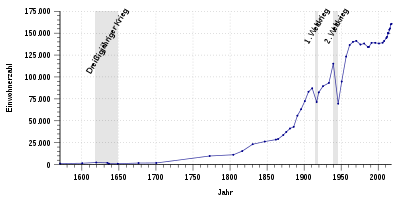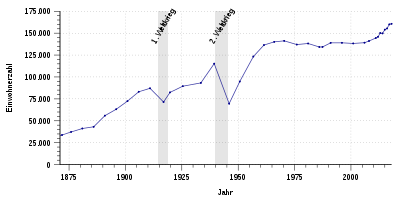Darmstadt
This is the sighted version that was marked on June 25, 2021. There are 2 pending changes that still need to be sighted.
![]()
The title of this article is ambiguous. For other meanings, see Darmstadt (disambiguation).
Darmstadt ( ![]() ) is a large city in the south of Hesse, administrative seat of the administrative district Darmstadt and the district Darmstadt-Dieburg. The city belongs to the Rhine-Main region and is one of the ten major centers of the state of Hesse. Darmstadt has about 160,000 inhabitants, making it the fourth largest city in the state of Hesse after Frankfurt am Main, Wiesbaden and Kassel. The nearest larger cities are Frankfurt am Main and Offenbach, about 30 km to the north, Wiesbaden and Mainz, about 40 km to the northwest, Mannheim and Ludwigshafen am Rhein, about 45 km, and Heidelberg, about 55 km to the south.
) is a large city in the south of Hesse, administrative seat of the administrative district Darmstadt and the district Darmstadt-Dieburg. The city belongs to the Rhine-Main region and is one of the ten major centers of the state of Hesse. Darmstadt has about 160,000 inhabitants, making it the fourth largest city in the state of Hesse after Frankfurt am Main, Wiesbaden and Kassel. The nearest larger cities are Frankfurt am Main and Offenbach, about 30 km to the north, Wiesbaden and Mainz, about 40 km to the northwest, Mannheim and Ludwigshafen am Rhein, about 45 km, and Heidelberg, about 55 km to the south.
Historically, Darmstadt was the capital and residence of the Landgraviate, the Grand Duchy and the People's State of Hesse. Its reputation as a "center of Art Nouveau" can be traced directly back to the artists' colony on Mathildenhöhe established by Grand Duke Ernst Ludwig in 1899. After the air raid during the Second World War, a large part of the old and inner city was destroyed. Since the postwar period, Darmstadt has distinguished itself as a city of science, a title awarded by the Hessian Ministry of the Interior in 1997. The city is home to a number of universities and research institutions, such as the Technical University, founded in 1877, the Darmstadt University of Applied Sciences, the Protestant University of Applied Sciences and the Wilhelm Büchner University of Applied Sciences, with a total of around 50,000 students. More than 30 other research institutions include the GSI Helmholtz Center for Heavy Ion Research, the European Space Operations Center (ESA/ESOC), the European Organisation for the Exploitation of Meteorological Satellites (EUMETSAT) and three institutes of the Fraunhofer-Gesellschaft.
In addition, there are numerous companies and institutions in the communications and IT industry that conduct applied research and development. These include Deutsche Telekom's second-largest location, Software AG, and Merck KGaA, a DAX-listed corporation. The city is home to the second-division soccer team SV Darmstadt 98. Darmstadt ranks 51st among Germany's largest cities.
_Panorama.jpg)
360° panorama of Darmstadt over Prinz-Georg-Garten; also visible: Herrngarten, TU Darmstadt; on the horizon: left Taunus, in the middle skyscrapers of Frankfurt a. M. and on the right Offenbach Show as spherical panorama

Darmstadt seen from the ISS
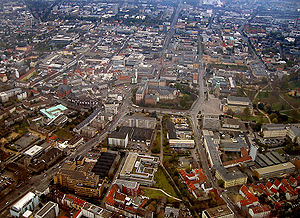
Aerial view from 2003: In the center is the Residence Palace, to the right are the Hessian State Museum and the Hessian State Archives; behind the Palace is the Ludwig Monument on Luisenplatz
Geography

enlarge and show information about the image
![]()
360-degree panoramic view from the Ludwig Monument - visible are: Kollegienhaus (right), the Hessian State Museum and the Hessian State Archives, Residenzschloss, behind it Mathildenhöhe with Wedding Tower, White Tower and City Church, Luisencenter and high-rise building of the Darmstadt University of Applied Sciences, Rheinstraße (center). On the right far in the background the Taunus with the Feldberg, on the left the Odenwald with the cone of the Melibokus. June 2012
![]()
enlarge and show information about the image
![]()
Darmstadt from the southeast Ludwigshöhe
Geographical position
Four natural areas meet in Darmstadt: The western part of the city is located in the Upper Rhine Plain. This is followed in the southern part of the city by the narrow fringe of the Bergstrasse, which begins here. The southeastern part of the city is part of the Vorderer Odenwald up to Mathildenhöhe. The northernmost point of the Odenwald lies on the B 26 near the Institute of Botany and Zoology. The northeast of Darmstadt, on the other hand, belongs to the Messeler Hügelland natural area. Among others, the Darmbach flows through the city and the Modau in the southern district of Eberstadt.
As a regional center, Darmstadt is also the central location for the districts of Darmstadt-Dieburg and Odenwaldkreis as well as the municipalities of the southern district of Groß-Gerau, an area with a total population of around 650,000. Neighboring centers are Frankfurt am Main in the north, Aschaffenburg in the east, Heidelberg and Mannheim/Ludwigshafen in the south, and Mainz in the northwest.
Neighboring communities
Darmstadt borders the district of Offenbach to the north and the district of Darmstadt-Dieburg to the east, south and west. It borders (clockwise from the north) the municipality of Egelsbach, the towns of Langen and Dreieich (all three in the district of Offenbach), the municipalities of Messel, Groß-Zimmern and Roßdorf, the town of Ober-Ramstadt, the municipalities of Mühltal and Seeheim-Jugenheim, the towns of Pfungstadt, Griesheim and Weiterstadt, and the municipality of Erzhausen (all in the district of Darmstadt-Dieburg).
City division and districts
The urban area of Darmstadt is divided into nine districts. For statistical reasons, they are divided into statistical districts, each of which is numbered. Of the total of nine districts, five belong to the inner city (districts 100 to 500) and four to the outer districts (districts 600 to 900). In detail, there are the following districts:
| No. | Designation | Area in hectares | Population (2017) | Note |
| 100 | Darmstadt Center | 232,7 | 20.200 | a. o. with city center and Eichberg quarter |
| 200 | Darmstadt North | 1.231,0 | 32.219 | including Johannesviertel, Martinsviertel and Waldkolonie with Europaviertel |
| 300 | Darmstadt East | 2.757,7 | 14.688 | with Mathildenhöhe and Woogsviertel, among others |
| 400 | Bessungen | 552,4 | 14.874 | incorporated on April 1, 1888 |
| 500 | Darmstadt-West | 1.514,7 | 18.901 | a. o. with Heimstättensiedlung |
| 600 | Arheilgen | 1.126,0 | 17.682 | incorporated on April 1, 1937 (*) |
| 700 | Eberstadt | 1.808,4 | 23.479 | incorporated on April 1, 1937 (*) |
| 800 | Wixhausen | 2.322,8 | 6.212 | incorporated on 1 January 1977 |
| 900 | Kranichstein | 655,0 | 11.907 | - — |
| Darmstadt | 12.200,7 | 159.982 |
|
(*) With the incorporation of Arheilgen and Eberstadt on April 1, 1937, Darmstadt became a major city.
Darmstadt's social geography shows a relatively strong divide between affluent and socially weaker neighborhoods, which has existed since the 19th century. In the core city (excluding outer districts), there is a clear east-west divide with the wealthiest residential neighborhoods on the eastern outskirts of the city from the Komponistenviertel in the north through Rosen- and Mathildenhöhe, Lichtwiese and Paulusviertel to Ludwigshöhe in the south. The city center with its reconstructed post-war buildings is average, while Johannesviertel and Martinsviertel in the north and Alt-Bessungen in the south are among the more desirable residential areas due to their partially preserved old buildings, where gentrification processes have been taking place since about 1975. In contrast, the western part of Darmstadt is characterized by a strong mix of commercial, residential and former military use, so that many conversion areas are located here and the high immission levels from industry and traffic as well as the partial lack of social infrastructure cause urban development problems. On the other hand, the west is the only inner-city area where a significant amount of new residential space can still be created to alleviate the general shortage in Darmstadt. Thus, this area along the Main-Neckar railroad as Weststadt has been the focus of Darmstadt's urban planning since the turn of the millennium and is undergoing major changes.
Climate
Darmstadt is located in the temperate climate zone. The average temperature is 10.1 °C. The warmest month is July with 19.3 °C on average. The coldest month is January with an average of 0.9 °C.
Darmstadt and the Rhine-Main region are located at the northern end of the Upper Rhine Plain, which is climatically one of the warmest regions in Germany. The annual average temperature of 10.1 °C (long-term average for the reference period 1981-2010) is above that of other German metropolises (Berlin 9.0 °C, Hamburg 9.1 °C, Munich 7.7 °C). The sun shines longest in July, averaging 7.5 hours a day. In December, the sun shines the shortest with an average of 1.2 hours a day. The climate is therefore quite mild overall. In the period from November to January, there are on average only one to two hours of sunshine during the day. The average precipitation is 765 mm per year.
Snow lies in winter on average on about fifteen days. The snow depth rarely exceeds ten centimeters and the snow usually does not stay for long. White Christmas occurs on average every 10 years.
The summer is quite warm with highs around 25 °C (on average eleven days a year even over 30 °C); in addition, it is slightly changeable with occasional showers or thunderstorms, but this is also the sunniest time with seven to eight hours daily.
The extreme values are about -21 °C in winter and about +39 °C in summer. The highest temperature ever measured in Darmstadt was 39.5 °C, measured on August 7, 2015. The lowest temperature ever measured in Darmstadt was -26.9 °C, measured on January 19, 1940. The average annual temperature increased by about 0.4 to 10.1 °C between 1981 and 2010.
The average annual precipitation was about 600-700 mm. The most precipitation falls in July, the least in April on average from 1981 to 2010. The average humidity is about 76%.
The prevailing wind direction is west.
Climate diagram from 1981 to 2010, for the city of Darmstadt
| Monthly average temperatures and precipitation for Darmstadt
Source: German Weather Service; wetterkontor.de | ||||||||||||||||||||||||||||||||||||||||||||||||||||||||||||||||||||||||||||||||||||||||||||||||||||||||||||||||||||||||||||||||||||||||||||||||||||||||||||||||||||||||||||||||||||||||||||||||

Luisenplatz with Ludwig monument
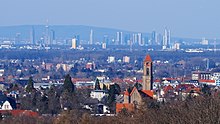
Darmstadt in the Rhine-Main area: view of St. Paul's Church with Frankfurt skyline
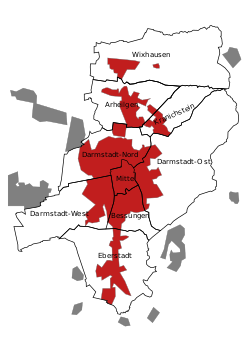
City layout graphically
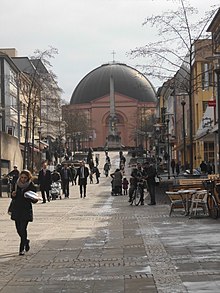
View through the Wilhelminenstraße to St. Ludwig
History
→ Main article: History of the city of Darmstadt
The name "Darmstadt
The origin of the name Darmstadt is unclear. The oldest preserved mention of the settlement under the name Darmundestat dates back to the 11th century, several centuries after the settlement was founded. The attempts to explain the origin of the name are very different:
- The local press prefers the explanation that Darmstadt was the fortified settlement of a royal Wildhübner named Darimund.
- Another interpretation sees the name as a derivation of the terms darre for gate or obstacle and mund for protection, thus Darmundestat would be a settlement at a fortified passage.
- Another derivation wants to recognize the Celtic word stems dar for oak or tree and mont for mountain.
- Furthermore, it is also tried to see in the Darmbach the origin of the name. Following this theory, Darmstadt would be either the site at the torrent (Dam-unda-stat) or the site at the moor brook (Darm-unda-stat). Against this thesis speaks, however, that the Darmbach was called so according to current knowledge only later.
Darmstadt is the only German city after which an element, Darmstadtium, was named.
→ Further detailed explanations of the name derivation in the parallel article: History of the city of Darmstadt
Historical name forms
Historically documented mentions of the place are (in parentheses the year of mention):
- Darmundestat (2nd half 11th century)
- Darmistat (1234)
- Darmstat
- Darmestat (1315)
- Darmstad (1377)
- Darmbstadt (1451)
- Darmstatt (1477)
- Darmstait (1479)
- Darmstadt (1488)
- Darmbstadt (1555)
- Darmstatt (1586)
- Darmbstatt (1600)
Incorporations
The municipality of Bessungen was incorporated on April 1, 1888. On April 1, 1937, Arheilgen and Eberstadt were added, as well as about 25% of Griesheim, including the military training area with the August Euler airfield, the Tann settlement and what is now Sankt Stephan. Wixhausen followed on January 1, 1977.
Spin-offs
On January 1, 1977, the St. Stephen's Settlement, with a population of about 2,000 at the time, was returned to the neighboring city of Griesheim.
Deserts
Klappach was a hamlet from the 13th to the 15th century, located south of the village of Bessungen near Darmstadt.
Population development
On April 1, 1937, the city's population exceeded 100,000 due to the incorporation of Arheilgen and Eberstadt. During World War II, the city lost about 40 percent (45,000) of its residents between 1939 (115,000 residents) and 1945 (70,000 residents). By 1953, the population had returned to its pre-war level. Darmstadt's population reached its previous high on December 31, 2016, with 159,982 registered residents.
The following overview shows the population figures according to the respective territorial status. Up to 1833, these are mostly estimates, thereafter census results (highlighted in color) or official updates of the respective statistical offices or the city administration itself. From 1843, the data refer to the "local population", from 1925 to the resident population and since 1987 to the "population at the place of principal residence". Before 1843, the number of inhabitants was recorded inconsistently.
|
|
|
|
Census results highlighted in color

Ernst-Ludwigs-Platz with White Tower after a postcard from about 1899
.jpg)
Darmstadt in 1816, a watercolor by Johann Heinrich Schilbach
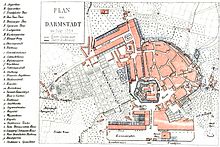
Oldest city map of Darmstadt from ca. 1759 by (Kaspar Ludwig) Bettenhäuser. (Note: East is up here.)

Darmstadt - Excerpt from Topographia Hassiae by Matthäus Merian 1655
Search within the encyclopedia
